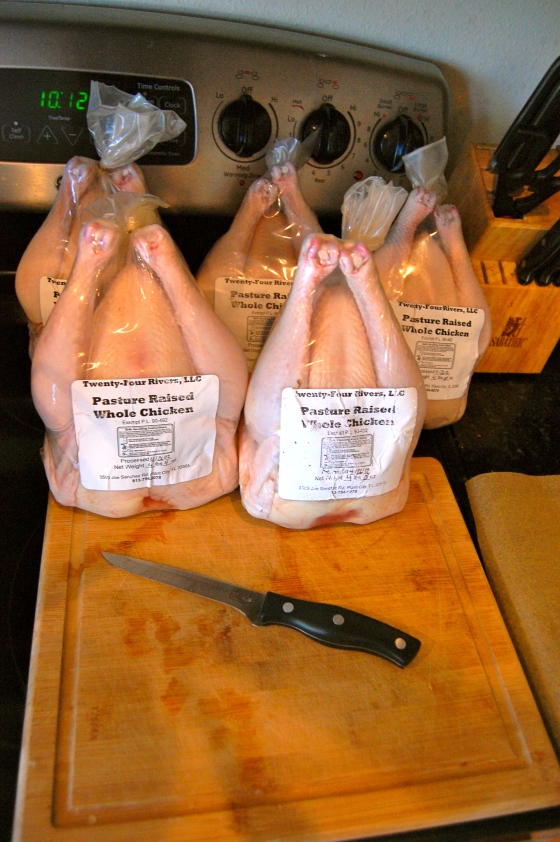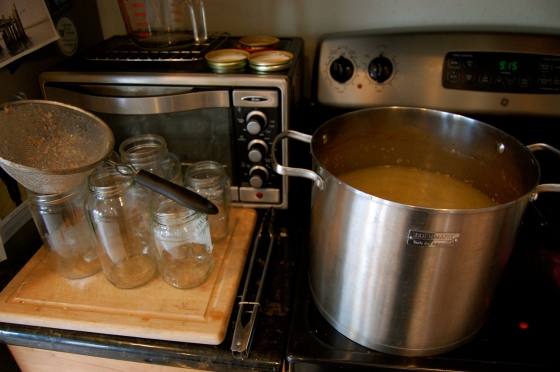Yesterday I told you all about my trip to the chicken farmer. If you aren’t used to working with whole chickens, you may be a bit intimidated by the thought of buying a bunch of birds all at once. Here’s the process I’ve used that works best for me and enables me to get the most for my money.
Pick a day when you have a good block of time. Start to finish, this whole process took me just over 2 hours. I did it on saturday morning when I didn’t have any other plans, and let the hubby sleep in while I was busy in the kitchen. Also very important, make sure you have a good boning knife! I didn’t have one when I first decided to switch to whole chickens. I searched all over creation and couldn’t find one in a store anywhere, so I bought one from Chicago Cutlery off Amazon. I’ve been quite happy with it. Remember, a boning knife is for de-boning meat, and is quite sharp! It’ll cut through bone, whether its yours or the chicken’s. Please be careful. And also, keep it sharp. They say the most dangerous knife is a dull one, and this is especially true when doing something that can be quite awkard, like processing a chicken.
Ok, now that you have some time set aside, your sharp knife, and your safety lesson completed, here’s how to actually get the job done. First, wipe down all your counters to make sure everything is clean. I use my homemade granite cleaner/disinfectant (promise to post the recipe soon!) Then wipe down your sink so you can use it to rinse the chickens. I recommend putting your trash can right next to the sink so you can immediately throw away the chicken bags without dripping juice across your kitchen floor (yes, I learned that one the hard way.) You may also want to set out some baking sheets covered with parchment paper if you plan on freezing the chicken parts. I do it this way rather than putting them all in a bag because it lets them all freeze individually rather than in a big lump. Set out your cutting board, knife, chickens, and, if you plan on making stock, a big stock pot ready for the carcasses. You’ll also need some apple cider vinegar and water for the stock.
I’m certainly not a pro at cutting up a chicken, though I have definitely gotten better since I started. If you are unfamiliar with the process, you may want to consult a cookbook like The Joy of Cooking, which has great diagrams. Or, if you want to watch it in action, check out these great videos from Gluten Free Girl.
Rinse your chicken and get to work cutting it up into all the various parts you want. Make sure to see if the gizzards are included, if so, either set these aside for another use or throw them away if you won’t use them. If you just want breasts, wings, and leg/thigh quarters, it won’t take you long to get those portions. (Well, it might the first time, but you’ll quickly catch on.) If you want boneless, skinless breasts, tenderloins, and thighs, that’ll add some time. The first time I cut up a chicken I think it took me an embarassingly long 30 minutes. By the time I was done with these 5 chickens, it was down to 15-20 minutes. As you cut up the parts, place them on the baking sheets. Make sure to wash your hands any time you have to touch anything clean. As you finish with each carcass, drop it in the stock pot. Take your trays of chicken and place them in your freezer for a few hours until they’re frozen enough to wrap individually. I use plastic wrap and gallon size zip lock bags. I ended up with 3 full bags from my 5 birds.
While the chicken is freezing, you can work on your stock. Fill your pot with water just enough to cover the carcasses, then add some ACV (I think I used 1/4 to 1/3 a cup for this size pot). Let this sit for about an hour, as the ACV will help withdraw minerals from the bones and make your stock as nutritious as possible. Use this time to wipe down your counters and clean your sink. If you threw away any of the skin or other chicken parts, I highly recommend you take your trash out now before your kitchen starts to stink.
After the hour has passed, turn your burner on low heat, I put mine at about 2.5. And thats it! Walk away and forget about it. I let mine barely simmer overnight, so it was on the stove for about 18 hours, though you certainly could do it for less time if you wanted. You could also season your stock with some salt and pepper and herbs, but I prefer to season it as I use it. When it’s done simmering, turn off the burner and let the stock sit, uncovered, for at least an hour to cool. Depending on how much you made, you may want to leave it longer. It doesn’t need to cool all the way, you just don’t want to burn yourself when pouring it into your jars.
Take out the bones and skim the stock. You’ll get a lot of little pieces that you don’t want floating around, try and get as much out as possible. Pour it into whatever containers you plan on freezing it in. I use glass jars that I’ve collected over the years, so I leave about an inch to an inch and a half of head space so that the jars don’t break in the freezer. I also find its much better to skim the stock in the pot, then to also pour it through the strainer into the jars. You get more of the nasty bits out this way!
Once you’ve poured it into the jars, let them sit on the counter until cool, then store in the fridge or freezer. You’ll notice a layer of fat on the top, this will help preserve the stock until you’re ready to use it. This part of the process took me probably 15-20 minutes, including the time it took to make my kitchen presentable enough for pictures.
So, from my 5 chickens, I got three full freezer bags of meat, and approximately 216 ounces of stock. At $4.50 a pound, I saved $2.49 a pound by not buying the precut, natural chicken meat from the grocery store. Granted, the grocery store chicken is all meat, without any bones. But from the bones I was able to get 216 ounces of broth. Buying that much organic, free range stock from my local health food store would have cost me $32.00. I estimate I saved roughly $73 by processing my own chickens, and I know they are clean, free range, high quality birds.
I hope this makes processing birds seem a little less intimidating. And one added bonus: fewer trips to the grocery store! That’s always a plus in my book.
This post is part of Sunday School at Butter Believer and Sunday Night Soup Night at Easy Natural Food, as well as Fat Tuesday at Real Food Forager and Frugal Days, Sustainable Ways at Frugally Sustainable.






Wow, what a great post! I have bought whole chickens before but have always cooked them whole….I’ve never tried cutting them up for different purposes, but its a great idea. Thanks for sharing this with Sunday Night Soup Night, look forward to seeing you again soon!
I have chosen this soup as one of my top 3 picks from Sunday Night Soup Night! I have tweeted it, pinned it and shared it on my Facebook page. It will be featured on Sunday Night Soup Night this coming Sunday. Thanks for linking up and I hope to see you again soon!
I’m glad you enjoyed it so much! Thanks for sharing my post on your page!
WEre the chickens frozen when you purchased them? All of the meats I buy from local farmers have been flash frozen at the butcher. I do like your plan though, any thoughts?
Also, when I cook the bird, I save the carcass for stock- but sometimes they get a little freezerburned while waiting to accumulate two or three carcasses. Any thoughts?
Courtney-
My birds were not frozen. I bought the chickens from the farmers the day that they processed them, so they were refrigerated but not frozen. If you found out the day the chickens were going to the butcher, you might ask if you could pick them up fresh that day or perhaps the next.
I have also frozen carcasses in the past for making stock, and some have gotten freezer burn. I went ahead and used them anyway and didn’t notice any difference in the taste of the stock, so I think you’d be ok. Freezer burn is really just some ice crystals on the surface anyway, so it shouldn’t cause a problem for you.
Best of luck!
Leah